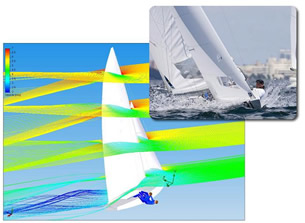Latest News
July 7, 2008
By DE Editors
 This 3D air-flow analysis using EFD.Lab reveals massive flow separation behind the Star jib sail at angles near stall. |
Flomerics (Marlborough, MA) reports that Finland-based sail maker WB-Sails is using EFD.Lab fluid dynamics simulation software to develop and optimize sails for Star and Finn class Olympic sailboats at the Beijing Olympics in August 2008.
Head of R&D at WB-Sails Mikko Brummer explains he needed “to predict 3D air flow and sail forces on downwind legs and in the lighter winds that we expect in Beijing…. In EFD.Lab we found exactly what we were looking for — an extraordinary ease of use provided by features such as ‘direct CAD-to-CFD’ technology and automatic mesh generation.”
WB-Sails used EFD.Lab to pinpoint problem areas in sails where flow separation is likely to occur. Flow separation reduces the driving force in the sail and increases drag. Simple sail trim changes can be performed directly within the software, and the close coupling with CAD software makes it easy to change components such as sails and rigging. For regions of particular interest, a denser local mesh can be created quickly, making it possible to investigate detailed flow phenomena in a reasonable time using an ordinary desktop PC.
The EFD.Lab CFD software allows nonuniform air-flow conditions to be specified at the entry plane to represent the atmospheric boundary layer at the sea’s surface. When combined with the speed of the boat, this results in a complex “sheared” and “twisted” wind pattern approaching the sails. The built-in graphical postprocessor in EFD.Lab enabled air-flow trajectories and pressure forces to be visualized with full 3D animation, making it much easier to understand the results. Driving force, heeling force and turning moments are calculated and output in absolute and coefficient form. These forces are then used to predict and optimize the sailboat’s performance.
For more information about EFD.Lab, visit Flomerics.
Sources: Press materials received from the company and additional information gleaned from the company’s website.
Subscribe to our FREE magazine, FREE email newsletters or both!
Latest News
About the Author
DE’s editors contribute news and new product announcements to Digital Engineering.
Press releases may be sent to them via [email protected].






